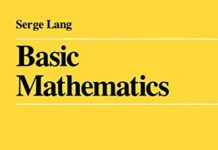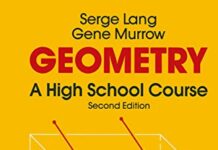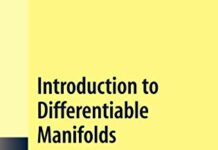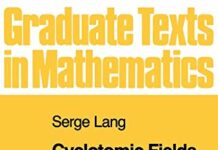
Ebook Info
- Published: 1993
- Number of pages: 594 pages
- Format: PDF
- File Size: 28.74 MB
- Authors: Serge Lang
Description
This book is meant as a text for a first-year graduate course in analysis. In a sense, it covers the same topics as elementary calculus but treats them in a manner suitable for people who will be using it in further mathematical investigations. The organization avoids long chains of logical interdependence, so that chapters are mostly independent. This allows a course to omit material from some chapters without compromising the exposition of material from later chapters.
User’s Reviews
Reviews from Amazon users which were colected at the time this book was published on the website:
⭐I’ve read through many analysis texts and in real analysis this is certainly among the very best. General integration and measure theory are covered in a self-contained way.. Recently I reviewed a real analysis text by Richard F Bass and found that some proofs on sigma algebras relied on the theorem that an open subset of R can be written as a countable union of disjoint open intervals (countable in the sense of finite or countably infinite). Lang accomplishes the same ends without direct use of this theorem, though you’ll see the ideas which put together furnish a proof of this theorem peppered throughout the development.In years past I had the privilege of working through Lang’s Algebra 2nd Ed. A proof of Zorn’s Lemma via the Bourbaki Theorem is given in Appendix 2 to this text. This proof is essentially reproduced on pp.10-16 of the reviewed text. Most notable there were errors in the proof of Lemma 2.3 in the algebra text. This lemma is 3.3 in the reviewed text. It appears that a posthumous attempt was made by an editor to correct it. Go down to the line on p.15 where it reads “whence x is an upper bound for E whence” b less than or equal to x( not c), a contradiction since it was assumed x less than b. Now it’s correct. So minor yet if you followed along you knew it was off and figured out the correction. Oh b an element of E does not follow here. What does follow is that for some c of E, x is less than or equal to c. I suspect Lang left the errors in purposely because it was a long chain of reasoning and this so strategically placed reinforced your understanding making you review the definitions. You’ll see what I’m talking about when you read it.The other reviewers pretty much covered the content. This text actually does distributions also as well as Dirac families and sequences for approximations of functions. Physicists and engineers should find this useful. If you’ve used a normalized Gaussian as a weighting factor for a current distribution in a wire say and calculated the resulting magnetic field-take the limit as the standard deviation goes to zero yikes! You saw it in practice.This text covers more than Royden. A start is made on infinite dimensional manifolds with Stokes’ Theorem toward the end. It’s easier than Royden too as complexity is arrived at in bite size pieces. A must-have for serious analysts.
⭐I’ve read several analysis books and this is one of the better ones that I have read. It covers a variety of interesting and useful topics and the exposition is clear. It’s presentation is a bit more abstract than some others starting with some functional-analytic concepts before doing integration in that framework. However, if you want to study stochastic analysis, getting in this frame of mind will definitely help your understanding of stochastic integration. For a truly thorough understaning of the subject, I recommend purchasing this book as well as the somewhat easier “Lebesgue Integration on Euclidean Space” by Frank Jones – the two together cost about the same as Royden, Rudin, or the terrible book by Aliprantis.
⭐This isn’t an ‘analyst’s analysis textbook’. But for those whose field of comfort lies outside analysis, Lang does a great job of conveying the logical structure of the canonical first-year graduate analysis syllabus in a somewhat unconventional way. For instance, he does as much of integration theory as can reasonably be done with Banach space-valued measurable functions, showing that the theory doesn’t necessarily depend on special properties of the real or complex numbers, but on the fundamental properties of linearity and completeness. This is also an excellent reference because Lang covers such a wide range of material.
⭐The author seems allergic to mathematical symbols and notation and fail to understand that it’s very often much clearer when every steps in a proof are written in symbols. There is a right balance. Too much symbols would be the typical french style like Brezis, this is the complete opposite and this is the first time I stop reading a book because of this problem, this is a pain in the a** to read seriously. The book seems to have a pretty good range of topics that are not covered in details elsewhere though, it’s a shame…
⭐Excellent last version of the classic.
⭐Book was in mint condition and delivered within timeframe promised.
⭐As an introduction to topological spaces, spaces of continuous functions, Banach and Hilbert spaces, and integration, there are many books that are better than this one. What this book is exceptionally good for is differential calculus with Banach and Hilbert spaces. Things like the mean value theorem, Taylor’s theorem, and the inverse function theorem are proved in the setting of Banach spaces, and there is a proof of the Morse-Palais lemma for Hilbert spaces. Also, there is a decent summary of Stieltjes introduction, better than the meager presentation most measure theory books include.
⭐Up to my knowledge, this is the only book that constructs the Lebesgue integral for functions to a general Banach-space instead of the real numbers (thus saving us from the unnecessary and esthetically dissapointing construction through positive and negative functions).I don’t know how Lang does it, but eerytime you’ll pick up one of his books, you’ll marvel at the beauty of mathematics !
⭐Un testo da avere per chi studia matematica anche se all’inizio di lettura un po’ ardua vista la diversa impostazione rispetto alla maggior parte dei manuali italiani e anche rispetto alla maniera classica di presentare l’analisi reale nella scuola italiana (da subito molto teorica rispetto al Calculus che è la base undergrad USA)Se trata de un libro de matemáticas avanzado. Había usado el libro de Walter Rudin (“principles…”) para ponerme al día para un doctorado en economía; este libro (y su hermano menor “Undergraduate analysis”) es menos sintético, cubre más materia y lo usé como libro de referencia para profundizar algunos temas.Lang escribe muy bien, explica fantásticamente y realmente vale la pena leerle.
⭐
Keywords
Free Download Real and Functional Analysis (Graduate Texts in Mathematics, 142) 3rd Edition in PDF format
Real and Functional Analysis (Graduate Texts in Mathematics, 142) 3rd Edition PDF Free Download
Download Real and Functional Analysis (Graduate Texts in Mathematics, 142) 3rd Edition 1993 PDF Free
Real and Functional Analysis (Graduate Texts in Mathematics, 142) 3rd Edition 1993 PDF Free Download
Download Real and Functional Analysis (Graduate Texts in Mathematics, 142) 3rd Edition PDF
Free Download Ebook Real and Functional Analysis (Graduate Texts in Mathematics, 142) 3rd Edition





